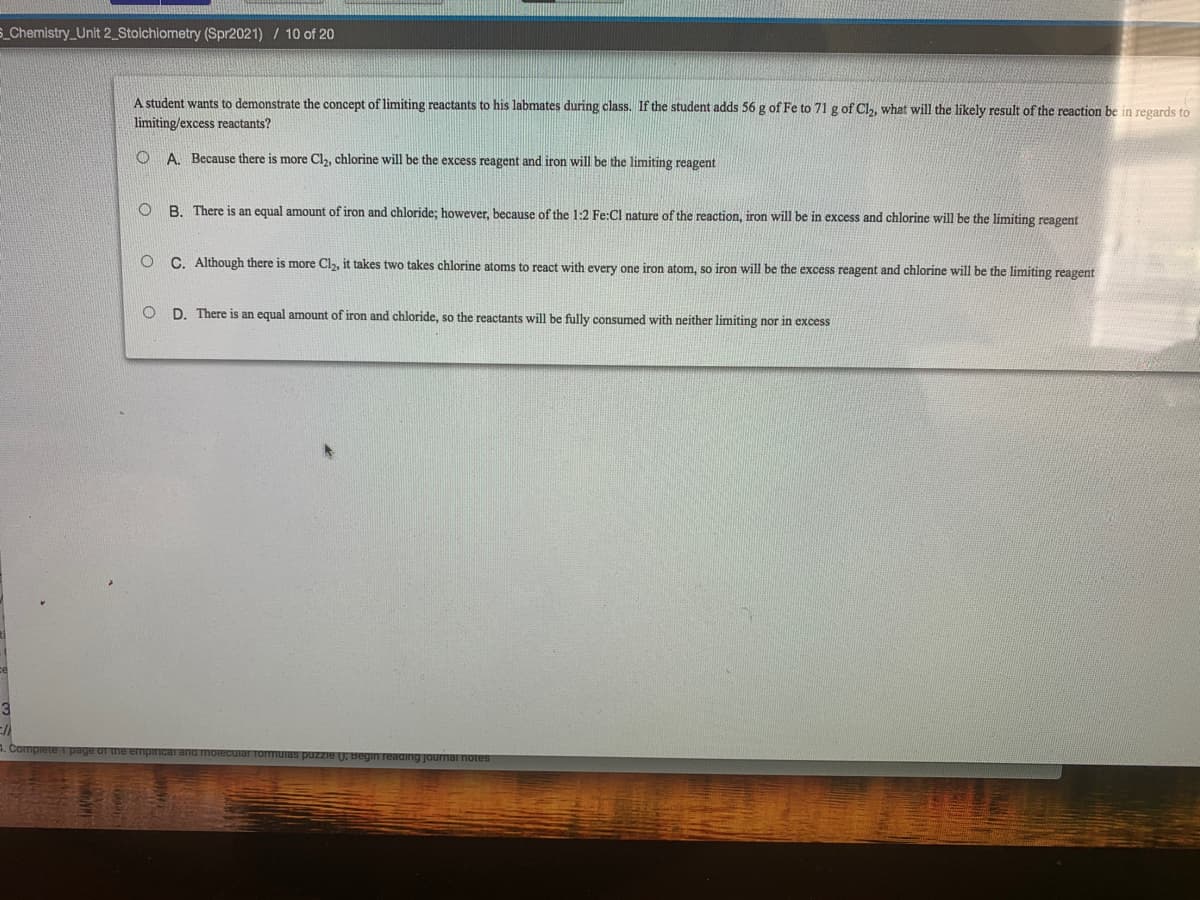A student wants to demonstrate the concept of limiting reactants to his labmates during class. If the student adds 56 g of Fe to 71 g of Cl,, what will the likely result of the reaction be in regards to limiting/excess reactants? O A. Because there is more Cl2, chlorine will be the excess reagent and iron will be the limiting reagent B. There is an equal amount of iron and chloride; however, because of the 1:2 Fe:Cl nature of the reaction, iron will be in excess and chlorine will be the limiting reagent C. Although there more Cl2, it takes two takes chlorine atoms to react with every one iron atom, so iron will be the excess reagent and chlorine will be the limiting reagent O D. There is an equal amount of iron and chloride, so the reactants will be fully consumed with neither limiting nor in excess
A student wants to demonstrate the concept of limiting reactants to his labmates during class. If the student adds 56 g of Fe to 71 g of Cl,, what will the likely result of the reaction be in regards to limiting/excess reactants? O A. Because there is more Cl2, chlorine will be the excess reagent and iron will be the limiting reagent B. There is an equal amount of iron and chloride; however, because of the 1:2 Fe:Cl nature of the reaction, iron will be in excess and chlorine will be the limiting reagent C. Although there more Cl2, it takes two takes chlorine atoms to react with every one iron atom, so iron will be the excess reagent and chlorine will be the limiting reagent O D. There is an equal amount of iron and chloride, so the reactants will be fully consumed with neither limiting nor in excess
Living By Chemistry: First Edition Textbook
1st Edition
ISBN:9781559539418
Author:Angelica Stacy
Publisher:Angelica Stacy
ChapterU4: Toxins: Stoichiometry, Solution Chemistry, And Acids And Bases
Section: Chapter Questions
Problem 12RE
Related questions
Question
I chose b was I right please help?

Transcribed Image Text:S Chemistry_Unit 2_Stoichiometry (Spr2021) / 10 of 20
A student wants to demonstrate the concept of limiting reactants to his labmates during class. If the student adds 56 g of Fe to 71 g of Cl,, what will the likely result of the reaction be in regards to
limiting/excess reactants?
A. Because there
more Cl,, chlorine will be the excess reagent and iron will be the limiting reagent
B. There is an equal amount of iron and chloride; however, because of the 1:2 Fe:Cl nature of the reaction, iron will be in excess and chlorine will be the limiting reagent
C. Although there
more Cl,, it takes two takes chlorine atoms to react with every one iron atom, so iron will be the excess reagent and chlorine will be the limiting reagent
O D. There is an equal amount of iron and chloride, so the reactants will be fully consumed with neither limiting nor in excess
rical and moiecuiar formuias puzzie U; Begin reading journainotes
Expert Solution
This question has been solved!
Explore an expertly crafted, step-by-step solution for a thorough understanding of key concepts.
This is a popular solution!
Trending now
This is a popular solution!
Step by step
Solved in 2 steps

Knowledge Booster
Learn more about
Need a deep-dive on the concept behind this application? Look no further. Learn more about this topic, chemistry and related others by exploring similar questions and additional content below.Recommended textbooks for you

Living By Chemistry: First Edition Textbook
Chemistry
ISBN:
9781559539418
Author:
Angelica Stacy
Publisher:
MAC HIGHER

Chemistry: Matter and Change
Chemistry
ISBN:
9780078746376
Author:
Dinah Zike, Laurel Dingrando, Nicholas Hainen, Cheryl Wistrom
Publisher:
Glencoe/McGraw-Hill School Pub Co

Introductory Chemistry: A Foundation
Chemistry
ISBN:
9781337399425
Author:
Steven S. Zumdahl, Donald J. DeCoste
Publisher:
Cengage Learning

Living By Chemistry: First Edition Textbook
Chemistry
ISBN:
9781559539418
Author:
Angelica Stacy
Publisher:
MAC HIGHER

Chemistry: Matter and Change
Chemistry
ISBN:
9780078746376
Author:
Dinah Zike, Laurel Dingrando, Nicholas Hainen, Cheryl Wistrom
Publisher:
Glencoe/McGraw-Hill School Pub Co

Introductory Chemistry: A Foundation
Chemistry
ISBN:
9781337399425
Author:
Steven S. Zumdahl, Donald J. DeCoste
Publisher:
Cengage Learning

Chemical Principles in the Laboratory
Chemistry
ISBN:
9781305264434
Author:
Emil Slowinski, Wayne C. Wolsey, Robert Rossi
Publisher:
Brooks Cole

Chemistry & Chemical Reactivity
Chemistry
ISBN:
9781337399074
Author:
John C. Kotz, Paul M. Treichel, John Townsend, David Treichel
Publisher:
Cengage Learning

Chemistry & Chemical Reactivity
Chemistry
ISBN:
9781133949640
Author:
John C. Kotz, Paul M. Treichel, John Townsend, David Treichel
Publisher:
Cengage Learning